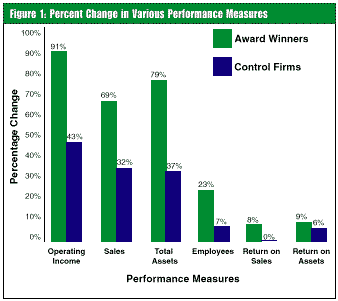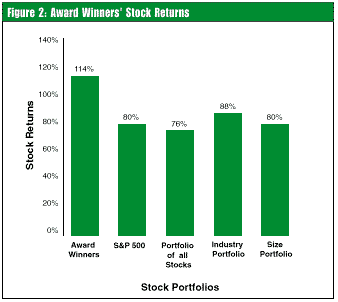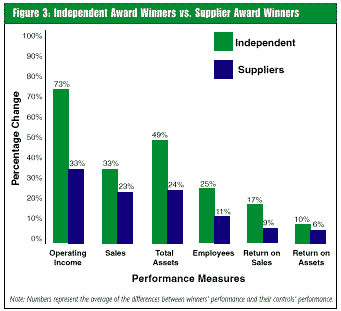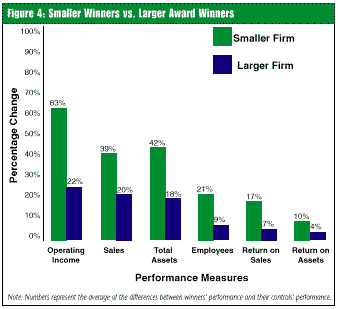|
What's as dead as a pet rock?" quizzes John A. Byrne in June's Business Week. "Little surprise here: It's total quality management." In his "Commentary" column, the magazine's senior writer rated TQM among a chorus line of more recent management theories and found it, like all the others, just another faded fad of the month.
The belle of the '80s, TQM has steadily lost ground to an endless succession of irresistible understudies, including reengineering, benchmarking, competitive gaming and, most recently, market migration analysis. During the '90s, the theory eventually was pronounced an official has-been and financial flop by most business magazines and newspapers.
However, TQM refuses to stay decently buried and forgotten. The much-maligned theory recently has been the subject of a seven-year study. Two professors, using empirical evidence, passed judgment on the financial success or failure of TQM programs. Taken out of the popularity lineup and examined realistically, how does total quality management fare? Astonishingly well for a purportedly dead business theory. But judge for yourself: The following review outlines the study and its results.
An empirical challenge
Kevin B. Hendricks, of The College of William and Mary's School of Business, and Vinod R. Singhal, of Georgia Institute of Technology's DuPree College of Management, began the study in 1991. At the time, TQM's credibility had fallen after much fanfare and expectation concerning the process's ability to sharpen U.S. manufacturing's blunted edge.
"Unrealistic expectations, a quick-fix mentality and competition from other paradigms are some reasons why many firms have soured on TQM," note Hendricks and Singhal in their report, "Impact of Total Quality Management on Financial Performance: Evidence from Quality Award Winners." And stampeding companies away from TQM is relatively easy, according to the study's authors. "All one has to do is show a few successful TQM implementations that didn't produce results -- for example, prestigious quality award winners that subsequently experienced poor financial performance," they continue.
The professors originally were motivated to research TQM after Singhal noticed an article in the Wall Street Journal about a company that won a prestigious quality award in 1991. He also noticed that the Dow Jones industrial average fell substantially that day, although the company's own stock rose.
Curious to discover whether the company's quality management program had influenced this phenomenon, Hendricks and Singhal decided to measure TQM's effects on long-term performance. "TQM suggests that organizations focusing on customer satisfaction, employee involvement and continuous improvement will improve their nonfinancial performance measures," they theorized. "Therefore, improvement in nonfinancial measures would lead to improved accounting-based measures, which ultimately would reflect in improved stock price performance."
Hendricks and Singhal thus began their study with three working hypotheses: A TQM program improves a company's profitability, it increases revenues, and it reduces costs.
What the study measured
The study used the winning of quality awards as a proxy for effective TQM implementation. "The core values reflected in the Baldrige criteria and related quality awards include customer-driven quality, continuous improvement, employee development, design quality, fast response, long-range outlook, management by fact and a focus on results, among other criteria," note Hendricks and Singhal. "These also are widely considered to be the building blocks of effective TQM."
Some 140 award givers were drawn upon in the study, among them independent bodies such as the National Institute of Standards and Technology, which oversees the Baldrige Award Program, various state quality award programs, and manufacturers, such as the Big Three automakers, that offer supplier awards. The study sample comprised nearly 600 award winners, 75 percent of which came from the manufacturing sector.
Hendricks and Singhal confined their study to publicly traded firms because that allowed them the flexibility to use objective and historical financial data. For study controls, they chose companies that were subject to similar economic, industry and competitive factors, and were of similar size as the award winners.
The percent change in operating income was the primary performance measure they tracked. Hendricks and Singhal defined operating income as income before depreciation -- i.e., net sales less cost of goods sold as well as sales and administrative expenses before depreciation, depletion and amortization.
The study required a long time period to establish the link between TQM and financial performance because of the theory's evolutionary rather than revolutionary nature. For the chosen award winners, Hendricks and Singhal established an implementation period beginning six years before and ending one year prior to when the companies won their first quality awards. The post-implementation period, during which the results of implementing TQM were observed, began one year prior to companies winning their first quality awards and ended four years after.
 Before and after: the results Before and after: the results
No significant differences in financial performance were noticed during any of the companies' implementation periods.
"This is good news," emphasizes Singhal. "We expected worsening performance during this period because of direct and indirect costs in implementing TQM. Possibly winners found easy improvement opportunities, and capitalizing on these paid off the implementation costs. But the results also could suggest that implementation costs might not be as high as believed."
In contrast with the implementation period, the post-implementation period showed significant results. Figure 1 indicates the percent change in performance measures overall for award winners and their controls. Winners experienced a 91-percent increase in operating income compared with their respective controls' 43 percent. Winners gained a 69-percent jump in sales compared with their controls' 32 percent and attained a 79-percent increase in total assets compared with controls' 37 percent. Winners also increased their employees by 23 percent compared with controls' 7 percent. More specific results include the following:
  Stock price performance -- Award winners' performance was compared with various benchmark portfolios. "Over a five-year period, award winners beat the S&P 500 index by 114 percent to 80 percent," observe the study's authors. "The 34-percent outperformance translated to an average market value creation of $669 million." Figure 2 shows the portfolios against which Hendricks and Singhal compared the award winners. They also outperformed a benchmark that included all stocks traded on the New York, American and NASDAQ exchanges, as well as against firms in the same industry and of similar size. Stock price performance -- Award winners' performance was compared with various benchmark portfolios. "Over a five-year period, award winners beat the S&P 500 index by 114 percent to 80 percent," observe the study's authors. "The 34-percent outperformance translated to an average market value creation of $669 million." Figure 2 shows the portfolios against which Hendricks and Singhal compared the award winners. They also outperformed a benchmark that included all stocks traded on the New York, American and NASDAQ exchanges, as well as against firms in the same industry and of similar size.
  Independent vs. supplier award winners -- The various award givers use differing criteria when evaluating a company's quality program, discovered Hendricks and Singhal. They reasoned that the different awards could indicate different TQM competency levels from one company to the next. "We used the winning of independent awards such as the Baldrige or state quality awards as a proxy for more mature TQM implementation as compared with supplier award winners," they explain. Independent vs. supplier award winners -- The various award givers use differing criteria when evaluating a company's quality program, discovered Hendricks and Singhal. They reasoned that the different awards could indicate different TQM competency levels from one company to the next. "We used the winning of independent awards such as the Baldrige or state quality awards as a proxy for more mature TQM implementation as compared with supplier award winners," they explain.
Both types of award winners gained from implementing TQM, but as Figure 3 indicates, independent award winners outperformed their controls by an average of 73 percent compared with the supplier award winners' 33 percent. Independent award winners also experienced a 39-percent increase in sales compared with suppliers' 23 percent.
  Smaller companies vs. larger -- Many managers believe that TQM is less beneficial to smaller firms, which they surmise can't afford the high implementation costs. Surprisingly, as Figure 4 indicates, smaller companies outperformed their controls by an average of 63 percent in increasing operating income, compared with 22 percent for larger companies. Smaller companies also showed a 39-percent increase in sales compared with larger companies' 20 percent. Smaller companies vs. larger -- Many managers believe that TQM is less beneficial to smaller firms, which they surmise can't afford the high implementation costs. Surprisingly, as Figure 4 indicates, smaller companies outperformed their controls by an average of 63 percent in increasing operating income, compared with 22 percent for larger companies. Smaller companies also showed a 39-percent increase in sales compared with larger companies' 20 percent.
As a possible explanation for these figures, smaller firms may be more flexible toward change. "Many key elements of TQM, such as teamwork, worker empowerment and cooperation across departments, already are present in smaller firms," explain Hendricks and Singhal. "Larger firms are more likely to have more layers of management, be organized across functional lines, have long-standing barriers between functional departments, and have a bigger and entrenched bureaucracy compared with smaller firms."
TQM and realistic expectations
Hendricks and Singhal's study represents one of few attempts to estimate realistically the long-term effects of implementing effective TQM programs. Their work shows that the link between quality and financial performance is strong. The conclusions from this study indicate that, despite negative publicity to the contrary, TQM does indeed pay off over the long term.
Briefly summarized, the study shows that quality award winners experienced increased income, sales and total assets during their respective post-implementation periods as compared with their controls. They also hired more new employees. Stock price performance for winners increased as compared with various benchmark portfolios. Winners of independent awards fared better than winners of supplier awards, though both categories did better than their controls. And, finally, smaller companies that won quality awards showed more improved operating incomes than larger companies.
The study's results may be good news for managers. A survey last year of vice presidents of quality indicated that nearly 75 percent of them are under considerable pressure to show the pay-off from quality. Hendricks and Singhal's findings should reassure these quality executives.
Yet, while most firms claim they have implemented TQM, few have done so effectively, according to the study's authors. Often, companies don't accurately track benefits from implementation, notes Singhal. They could benchmark from GE, whose recent annual report takes a look at the company's six sigma efforts. Basically, GE plugs in six sigma costs but looks at improvement, he relates. "GE creates a profit-and-loss statement, called a quality income statement, for its quality improvement," explains Singhal. "The numbers might be estimates, but these types of statements at least make companies look at their improvements."
TQM works when it is correctly applied, say Hendricks and Singhal. "Effective implementation means focusing on customer satisfaction, employee involvement and continuous improvement," they stress. "Most experts believe that TQM's gains are incremental rather than radical. Even after effective implementation, it still takes a couple of years before financial improvement begins."
But above all, organizations must remain patient when implementing TQM. "Companies often make the mistake of comparing themselves to Xerox -- whose TQM program represents an exemplary model -- and then become disappointed at their comparative results," observes Singhal. "Companies should set realistic expectations and consider themselves successful if they achieve them. They should plan to build TQM into their systems during two or three years, then add another two years to see results."
About the author
Taran March, Quality Digest's features editor, would like to acknowledge Vinod Singhal's help with this article. Singhal may be reached by telephone at (404) 894-4908 or e-mail vsinghal@qualitydigest.com . | 
